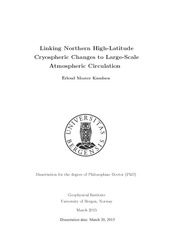Linking Northern High-Latitude Cryospheric Changes to Large-Scale Atmospheric Circulation
Doctoral thesis
Permanent lenke
https://hdl.handle.net/1956/9700Utgivelsesdato
2015-03-20Metadata
Vis full innførselSamlinger
- Geophysical Institute [1228]
Sammendrag
Warming twice as fast as the rest of the globe, the northern high-latitudes arguably show the clearest evidences of observed and projected climate changes. Two of these are the rapid loss of Arctic sea ice and the shrinking of the Greenland Ice Sheet. In this dissertation, three papers analyze the interaction between the cryospheric changes and the atmospheric circulation. In the first paper, summers of observed anomalous Arctic sea ice melt are composited in order to distinguish large-scale atmospheric patterns associated with sea ice loss. While a positive cloud feedback characterizes warm high-latitude summers, storms track more zonally in midlatitudes, leaving summers stormier, wetter and cooler in northwestern Europe and around the Sea of Okhotsk. Farther south, a heating band from the Mediterranean Sea to East Asia indicates an increased probability of heat extremes in these areas in summers of high Arctic sea ice melt. The second paper analyzes projected changes in Arctic sea ice and Northern Hemisphere storminess. Here, a general poleward-shift of the main storm tracks is revealed. Cyclone intensities generally follow cyclone frequencies, but with an elevated intensification over new open ocean areas. For most of the domain, precipitation increases significantly, with the highest enhancements along the poleward-shifted storm tracks and in the sea ice diminishing Arctic. Finally, the influence of cyclonic and anticyclonic activities on the observed Greenland Ice Sheet (GrIS) surface mass balance (SMB) variability annually is analyzed in the third paper. The synoptic features correlate with the SMB changes through their impact on temperature and snow accumulation. Generally, enhanced cyclonic activity contributes to increased snow accumulation over the GrIS by transporting more heat and moisture from the south. A warming effect also results from enhanced anticyclonic activity in summer, where fewer clouds increase the incoming shortwave radiation and thus surface temperature. Overall, up to 60 % of the regional SMB variability can be explained by these synoptic activities. All together, the three papers illustrate how the Arctic sea ice and the GrIS interconnect with local and remote changes in the atmospheric circulation. While various studies find the regional changes to significantly alter ecosystems, impact local communities and enhance industry potential, distant consequences might include sea level rise, elevated risks of extreme weather events, decline in agricultural production, economic disruption and hence political instabilities.
Består av
Paper I: Knudsen, Erlend M., et al. "Observed anomalous atmospheric patterns in summers of unusual Arctic sea ice melt." Journal of Geophysical Research: Atmospheres (2015). The article is available at: http://hdl.handle.net/1956/9858.Paper II: Knudsen, E. M., and J. E. Walsh. "Northern Hemisphere storminess in the Norwegian Earth System Model (NorESM1-M)." Geoscientific Model Development Discussions 7.6 (2014): 8975-9015. The article is available at: http://hdl.handle.net/1956/9701.
Paper III: Chen, L., Knudsen, E.M., et al. "The variability of surface mass balance over the Greenland Ice Sheet and associated cyclonic and anticyclonic activities". Full text not available in BORA.
